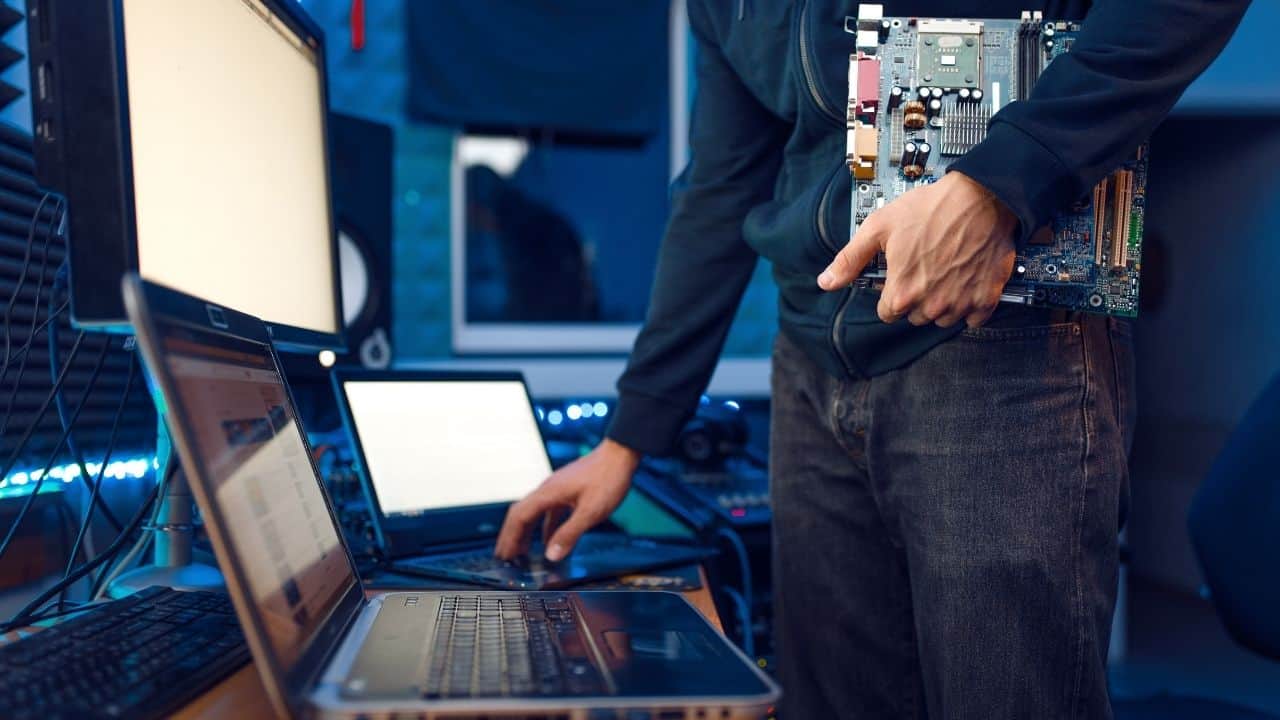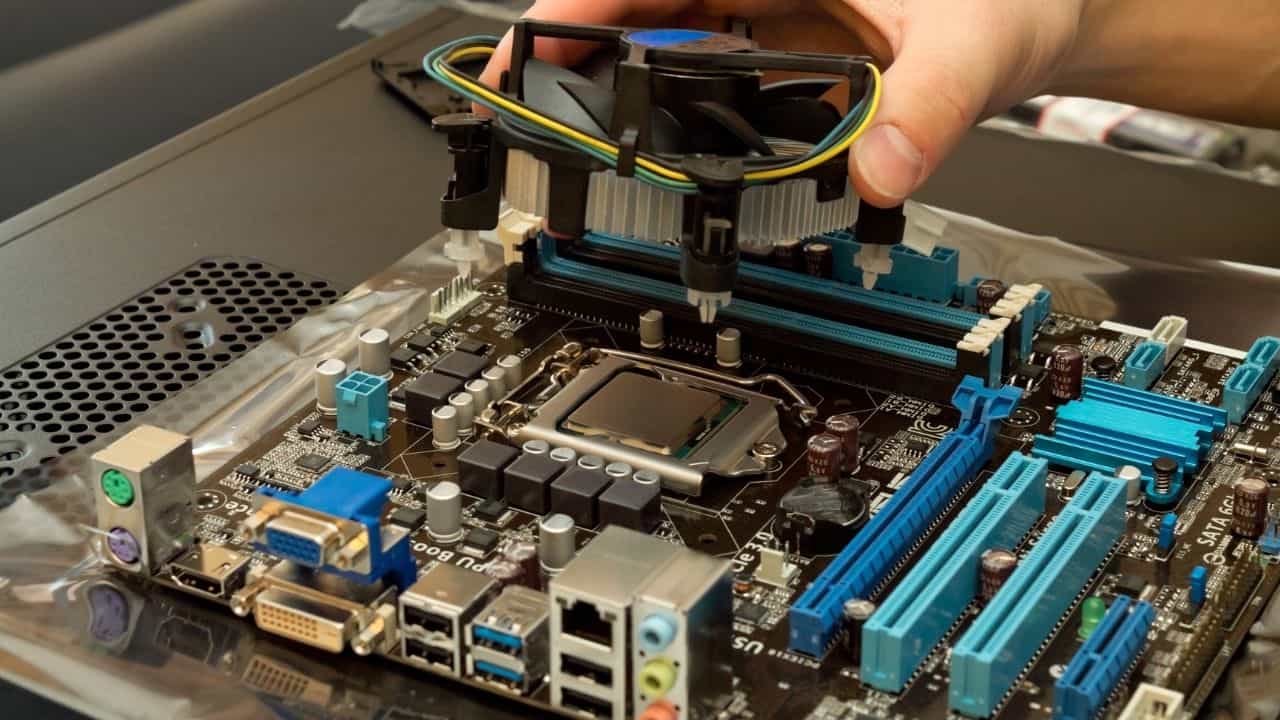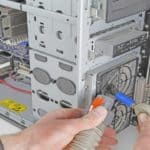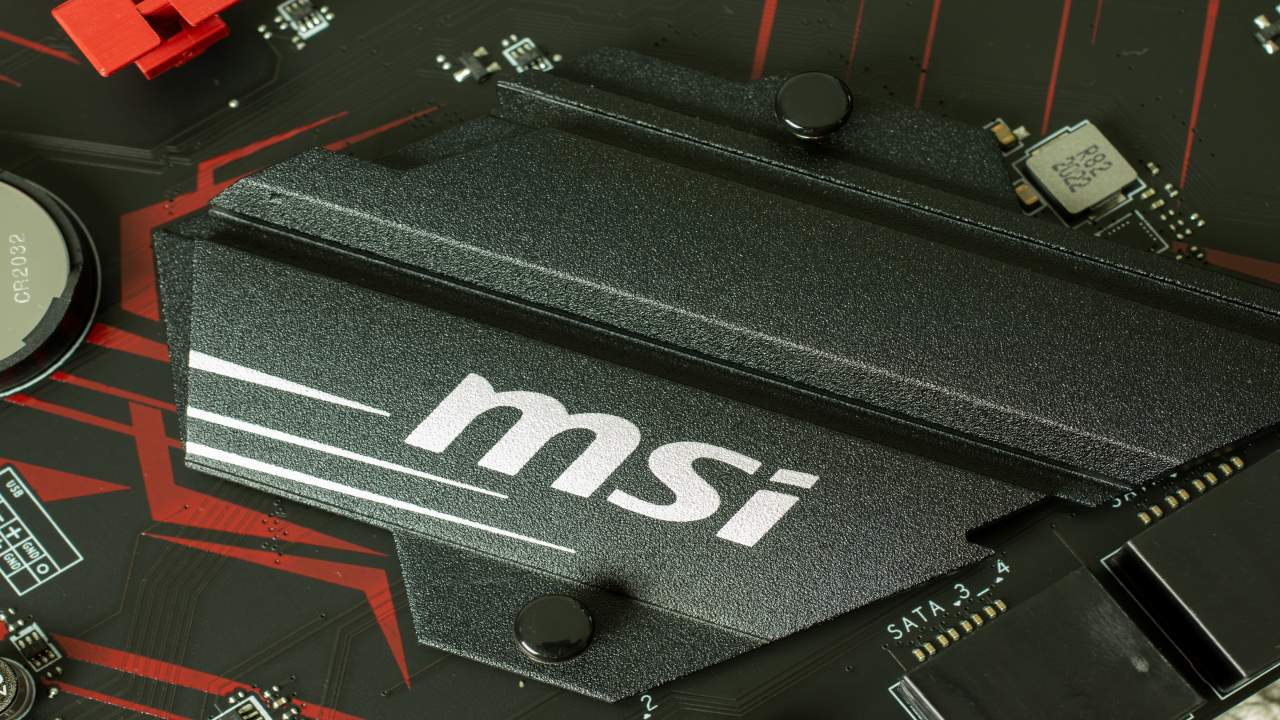- Front Case Fan Not Spinning: [3 Proven Fixes That Work - June 22, 2022
- Is 60 Degrees Celsius Hot For A CPU In 2022? [Must-Read] - June 7, 2022
- How To Handle CPU Temps Jumping: A Definitive Guide [2022] - June 2, 2022
It’s morning, your coffee is ready, your mind is sharp, and you are ready for work.
But, when you turn on your computer, all you can see is a blank screen. Motherboard won’t display on the monitor.
What could have gone wrong? Is the MSI motherboard not detecting the monitor or the MSI motherboard not detecting HDMI? Frankly, it becomes difficult to diagnose a problem when the screen is entirely blank.
The reason could be anything, maybe your computer is malfunctioning, or the problem is just relating to the monitor.
You may get a message on the screen notifying that motherboard HDMI No Signal or No Input or Cable Not Connected.
Or, in the worst case, all you have is a blank screen. Therefore, to troubleshoot such an issue, let us walk through some simple tips so you can get back to your work.
Contents
Understanding Why Motherboard Is Not Detecting Monitor?
1. External Connections Check
The first thing that you should check is whether the monitor is powered on or not and whether the video cable connection is proper or not.
Most blank screen issues occur due to loose connections, so checking the external connections is necessary. Here is what you need to do:
- While checking the video cable connection, check where the cable is connected. If you have a graphics card, the HDMI must be plugged into the graphics card and not the HDMI port on the motherboard. HDMI works on GPU but not motherboard.
- If the connection seems fine and still nothing comes up on the monitor, you need to identify whether the problem is internal or external.
- You can check the internal issue by pressing the NumLock or CapsLock keys on the keyboard repeatedly. If their lights blink on the keyboard, then the fault probably relates to the monitor or cable because the internals are working well.
- Now, it is time for you to try using a different video cable because there are chances of motherboard HDMI not working.
- If cross-checking the cable doesn’t turn out to be helpful, you can also cross-check the monitor.
- While checking the cables, disconnect all the cables that are not essential for booting up the computer. I’ve come across situations where particular USB ports prevent system booting if something is plugged into them. It may sound weird, but sometimes it happens.
2. Listen To The Beep Sound And Check Graphics Card, RAM, And Other Internal Hardware
You may have noticed that when your computer boots up, it makes a small beep sound. This sound comes from the speaker present in the CPU to indicate whether everything is okay or not.
If there is a quick beep when the PC boots, then it means that the system isn’t registering any hardware issue. However, when you hear specific types of beeps, like a long beep, or two short beeps, the system is trying to send an error code that something is wrong.
The error could be anything, either a failing RAM stick, or an overheating CPU, or a loose graphic card. So, in such a case, you need to check the internal hardware; let’s see how:
- After cross-checking the monitor and ensuring that the issue is not relating to the motherboard HDMI not working gigabyte, it is likely that you are facing the problem because of a minor issue in the graphics card.
- The reason that we are checking the graphics card first is because it is responsible for managing all the graphical processes and displaying the outcome to the user. (If you don’t have a graphics card on your PC, you can skip this step.)
- There are chances that you haven’t cleaned the graphics card in a long time. Because of that, the golden contact area may have some corrosion which is disrupting the connection.
- So, remove the side panel of your CPU and look inside for the graphics card. Try to remove it, and if after removing the computer boots up properly, the fault is in the card.
- Clean the card, and re-insert it into the PCIe slot. When you hear a clicking sound, it means that your card is appropriately placed.
- If, after re-inserting, the problem continues, you can try inserting the card in a different slot. If that also doesn’t work, it is time for you to change the card.
- If the Graphics card is okay and you are still facing the No Display Issue, you can check the RAM stick too. To pop out the RAM stick, press down the lever near the edge. Then, clean the RAM and place it back. You can also cross-check the RAM, just like the graphics card.
- Even after checking the graphics card and RAM stick, the problem continues; you need to check the additional internal hardware. There are a number of extra hardware that doesn’t have any role in the boot-up process, like the SSD, FDD, DVD-RW, hard drive, external card, etc. The startup process only requires RAM, Processor, Graphics Card, SMPS, and a CPU Fan. So, detach all the extra hardware and try starting the PC. If the PC turns on, it means that you are having issues with one of the additional hardware.
3. Fixing The Boot Order
Sometimes, your monitor will show you a black screen because the system is trying to boot from the wrong hard drive. You can fix this with ease; just adhere to the following instructions:
- First, get into the BIOS setup menu. You can enter by pressing keys like DEL or F2 unusually when your computer reboots.
- Search for the boot order option in the BIOS menu. In the boot order option, ensure that the correct hard drive is selected and is at the top of the list.
- After that, just save the settings and exit from the menu. If everything goes well, your OS will reboot properly.
- If this trick doesn’t work, you can load the default setting from the BIOS. Doing so will fix anything misconfigured by you in the past which caused the problem. And the system will reboot normally.
4. CMOS Battery Checkup
The work of the CMOS battery is to deliver a small amount of power continuously to the motherboard’s BIOS for the purpose of saving the current setting such as Date, Time, Boot settings, etc.
It is possible that the reason behind your PC’s starting up issue is the draining of the CMOS battery.
The solution to this problem is to remove the CMOS battery and start the system. If the system starts and the motherboard detects the monitor, change the CMOS battery cell and configure the BIOS setting properly.
5. Checking The Motherboard
Even after trying everything, if the motherboard is still not detecting the monitor, there is a high chance that some big issue is there in your computer’s main hardware, i.e. motherboard.
But, it is challenging to test the motherboard without professional machines and assistance.
All you can do is try testing your computer by connecting the CPU with some other working motherboard.
Yes, you can do so; just make sure that the other motherboard is compatible with your PCs processor.
If your CPU is working fine on the other computer, then it’s time for you to find the fault in your motherboard.
What To Do If Motherboard Won’t Detect A Second Monitor?
Using a second monitor such as AOC is very common these days. This makes it convenient for the user to work on multiple apps, expand the working space, or even play games.
Although connecting a second desktop is a straightforward process, but sometimes, the system is unable to detect a second monitor due to some drive or hardware-related issues. However, if you face such an issue, some simple steps can help troubleshoot the problem quickly.
Have You Plugged Into The Right Port?
Let us skip to the basic stuff, assuming that you have already performed it, like checking the loose connections and cross-checking the cables. Now, we should start with a bit advanced issue: your second monitor is not plugged into the correct port.
Keep a note that if your PC has a dedicated graphics card, then all the connections relating to visual output will be connected to the card. Monitor cables, like HDMI, VGA, DVI, etc., if connected to the motherboard, will not work.
In any situation, if you want ports of both your GPU and motherboard to work (for example, you want to connect a VGA monitor alongside your HDMI monitor and the graphics card lacks a VGA port), you can do so by changing your PCs BIOS settings and making your integrated/motherboard as your primary display adapter.
This way, your motherboard ports will be active, and at the same time, your graphics card will still work.
Force Windows To Detect Display
Windows usually detect the second display as soon as you plug it in. However, if you are using an old monitor, or if there is any software issue, the display will not be detected automatically. In such a situation, you will need to manually get Windows to detect the second computer.
All you have to do is:
- Right-click on the desktop.
- Go into the display settings.
- Then under the “multiple displays” section, click on the detect button.
Roll Back Or Reinstall Graphics Card Driver
If you are experiencing the issue after you updated the GPU driver, then it is likely that that’s where the root of the problem exists. To fix this, you can try to roll back the GPU driver to the previous version.
For rolling back the driver:
- Go to “Device Manager”.
- Under the “Display Adapters” section, locate your graphics card.
- Right-click on the graphics card and go into the “Properties”.
- In the “Driver” tab, you will find the “Roll Back Driver” button. Click on that and follow the instructions as specified.
- Then reboot the PC, and most probably, the motherboard will detect the second monitor now.
After that, to be on the safer side, you can wait for the release of the even more recent version of the driver and update it.
Using old drivers is also a common reason for MSI afterburner clock issues.
Also, don’t forget to regularly clean your motherboard with wd40 to avoid issues caused by debris.
Tips To Make Sure It Doesn’t Repeat In Future
- Ensure that the monitor is connected to a proper power source.
- Ensure that it is turned on.
- Refresh the connection by turning the monitor off and then turn it on again.
- Check that the correct input option is selected by pressing the menu button on the monitor.
- Ensure that the brightness is turned up.
- Check the cable connections.
- Cross-check the cables.
- Check whether the video cable is connected to the correct port or not. When your PC has a graphics card, then HDMI works on GPU but not motherboard.
- If the Asus motherboard DVI port not working, try changing the port.
- Cross-check the monitor.
- Clean the graphics card and RAM stick from time to time so they work properly.
- Ensure that the BIOS settings are proper and the CMOS battery is not drained out.
FAQ (Frequently Asked Questions)
Why is my monitor not connecting to my motherboard?
One of the prime reasons for the monitor not connecting to the motherboard is the wrong connection. If your PC has got a dedicated graphics card, then the ports relating to the visual output connection will not work on the motherboard.
All the monitor cables need to go from the graphics card. If you want your motherboard ports to work, you can set the motherboard as the primary display adapter in BIOS settings.
How do I get my monitor to work on my motherboard?
It is an easy task. You just have to plug in the VGA cable of the monitor into the VGA port of the motherboard. Make sure that the VGA cables fit snugly into the port.
Once it is properly fit, tighten the thumbscrews on both edges. In case of a DVI adapter, plug the cable into the port present on the video card and then tighten the screws.
Will a monitor work if plugged into the motherboard?
By enabling the integrated setting in BIOS, you can make your monitor work by plugging it into the motherboard, even if you have a dedicated graphics card.
This way, ports of the motherboard will be active for your monitor to be plugged in, and the drivers will still pick up the graphics card.
Why is my motherboard not detecting my HDMI?
This may happen if the CPU onboard graphic HDMI output is not enabled.
To enable it, you need to go to the BIOS setting by repeatedly tapping Del or F8 key when the system boots up. Now, open the Advanced/System Agent Configuration/Graphics Configuration menu.
There, you will find “CPU onboard graphics multi-monitor” settings. If it is disabled, enable it, and you are good to go.
Final Words
In the article, we have covered all possible issues behind why your PCs motherboard is not detecting monitor. Along with the potential issues, we have listed the possible remedies to troubleshoot them. In addition to this, some additional tips are also being prescribed to ensure that such a problem won’t trouble you in the future. So, we hope that this article turns out to be of some value for you and help you deal with your PC issue quickly and conveniently.


![How To Change CPU Fan Speed Without Bios? [Easy Guide] How To Change CPU Fan Speed Without Bios? [Easy Guide]](https://maximum-tech.net/wp-content/uploads/2022/05/How-To-Change-CPU-Fan-Speed-Without-Bios-150x150.jpg)
![How To Know If CPU Is Dead? [A Comprehensive Guide 2022] How To Know If CPU Is Dead? [A Comprehensive Guide 2022]](https://maximum-tech.net/wp-content/uploads/2022/04/How-To-Know-If-CPU-Is-Dead-150x150.jpg)
![Best CPU For Programming In 2022 [7 Picks For Every Budget] Best CPU For Programming In 2022 [7 Picks For Every Budget]](https://maximum-tech.net/wp-content/uploads/2022/02/best-cpu-for-programming-150x150.jpg)


